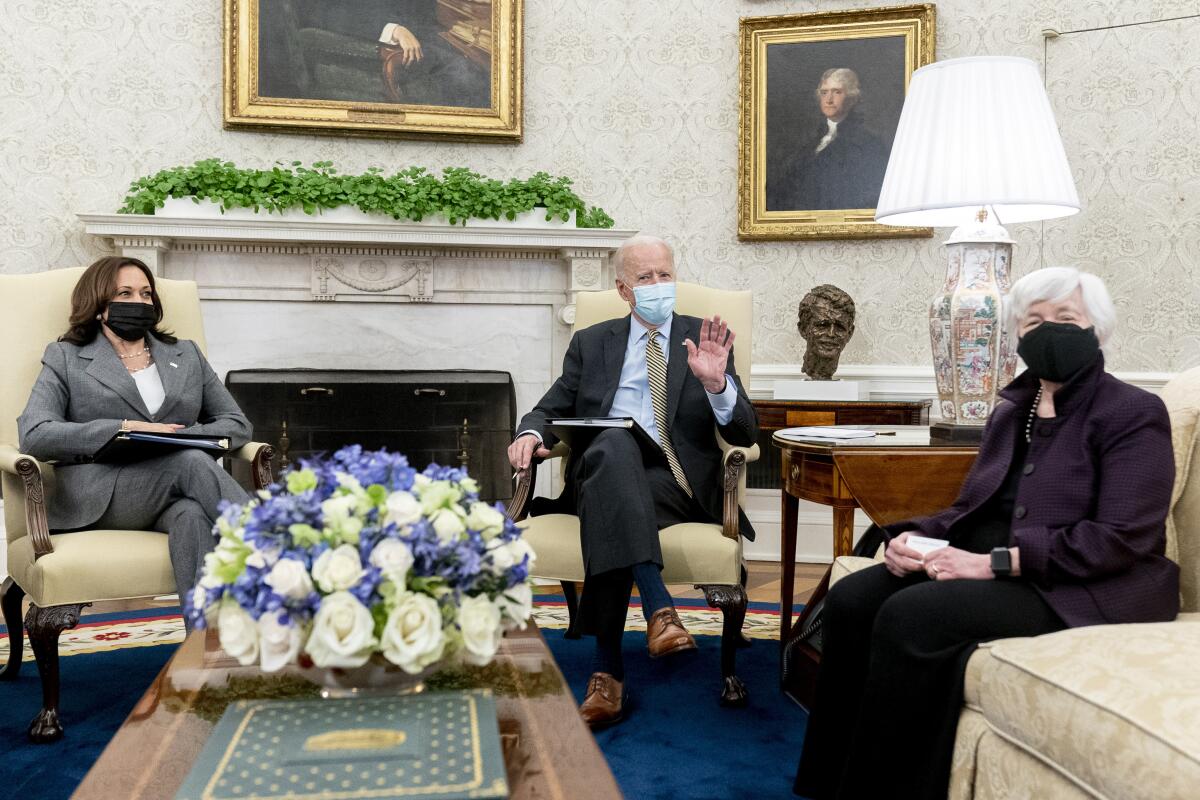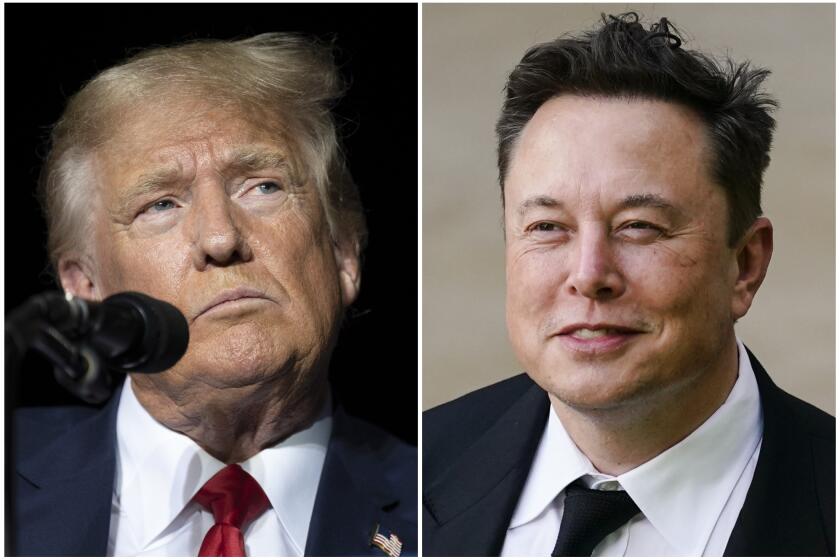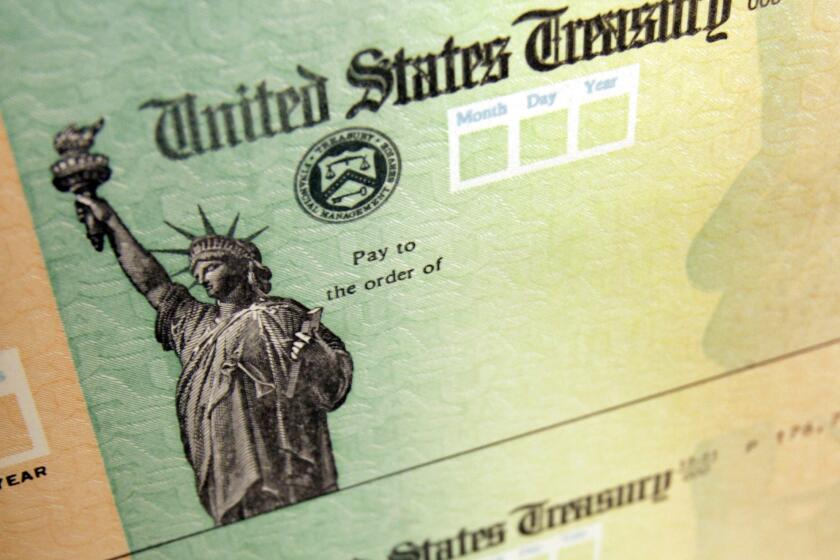Biden requests large boost in domestic spending for the next budget year

- Share via
WASHINGTON — President Biden, saying the U.S. has “significantly underinvested in core public services,” will ask Congress for a 16% boost in annual spending for a range of domestic programs, the White House announced Friday.
The first installment of Biden’s budget for the fiscal year starting Oct. 1 asks for just over $1.5 trillion for so-called discretionary spending — the roughly one-quarter of federal outlays governed by annual appropriations laws. Slightly more than half of the money would go to domestic programs, and the rest to national security.
The increase in domestic spending would expand programs on health, education, housing, scientific research and climate change, reflecting the priorities of the new administration. Money for civil rights enforcement and efforts to combat violence against women also would get large boosts.
Biden cited several of the new initiatives in brief comments to reporters Friday afternoon, saying he hoped to “get some bipartisan support” for the spending.
Although presidential budgets have largely been ignored in recent years, Biden’s is likely to receive a warmer reception on Capitol Hill, where Democrats control both houses of Congress and share many of the administration’s goals. With a slim majority in the House and an evenly divided Senate, however, many of Biden’s proposals will probably be changed — a likelihood White House officials conceded.
The budget is “an opportunity to outline the priorities of the existing administration,” White House Press Secretary Jen Psaki said, adding, “We’re at the beginning of ... what we know is a long journey” through Congress’ appropriations process.
While domestic programs would receive a big hike, defense spending, which got major increases under President Trump, would grow only slightly — just under 2%. Even that, however, drew objections from some progressive Democrats. Rep. Ro Khanna (D-Fremont) said in a statement that the Pentagon increase was “disappointing.”
A senior administration official who briefed reporters on condition of anonymity said much of the defense increase would go to raise pay for service members.
Biden also seeks to eliminate so-called overseas contingency operations accounts, a budgetary gimmick that allowed previous administrations to fund continuing conflicts in Iraq, Afghanistan and elsewhere without counting the spending against the Pentagon’s regular budget.
Biden’s proposed increases in discretionary spending come on top of three other large pots of money: roughly $1.9 trillion that Congress approved last month as part of his COVID-19 relief package, the infrastructure spending that he asked for last month as part of his “Build Back Better” plan, and additional spending to support families that he has said he will request later this spring.
The money requested for infrastructure and other purposes, more than $2 trillion, would be spent over an eight-year period, starting with the coming fiscal year. How much would be spent in the first year is not known. The money for families is expected to add at least $1 trillion, also over a multiyear period.
The administration officials who briefed reporters did not say what Biden’s total spending request would be, saying the full budget would be released later this spring. In the current fiscal year, the federal government is projected to spend about $5.8 trillion; the bulk of that covers entitlement benefits for Social Security, Medicare and Medicaid, which are automatically funded.
Big departure from Trump budgets
The spending request marks a major break from budgets submitted by Trump, who routinely proposed deep cuts in domestic programs that Congress largely rejected. Trump signed off on bipartisan spending plans that, combined with the tax cuts he signed into law in late 2017, swelled the federal deficit to record levels.
One of the biggest changes involves climate change. Biden is asking for $14 billion in new funding to address global warming, an issue Trump disparaged.
The White House said spending on climate programs is down 27% since 2010, adjusted for inflation. The new spending would be spread among a wide array of federal agencies.
Biden would also increase the budget for the Environmental Protection Agency by more than 20%, to $11.2 billion, in an effort to rebuild an agency that was severely depleted during Trump’s tenure.
But the budget also marks a significant departure from those submitted during much of President Obama’s tenure, when spending was constrained by caps that Congress imposed as part of a budget deal in 2011.
The spending caps expire on Sept. 30, providing what Shalanda Young, acting director of Biden’s Office of Management and Budget, said in a letter to Congress was a “unique opportunity” to begin reversing a long-term trend of declining investment in major priorities.
Although the spending increase for domestic programs is large, administration officials said that overall, it would restore domestic discretionary spending to roughly the average level of the past 30 years, relative to the size of the U.S. economy.
Increases for education
Administration officials highlighted several major funding increases for education. One of the largest would more than double aid to schools in areas of high poverty under the federal government’s Title I program. The increase, to $36.5 billion, would be the biggest for the Title I program since it was established under President Johnson more than half a century ago, administration officials said.
Biden said the “largest-ever funding increase” for the schools program would give “millions of children in low-income families” a chance to “compete all the way through high school and beyond.”
Title I money is a major source of funding for urban school systems as well as many low-income rural ones. Prior to the COVID-19 pandemic, Title I accounted for about 5% of the giant Los Angeles Unified School District’s almost $8-billion budget.
Biden would also expand Head Start spending by more than 10%, to $11.9 billion. Over the past decade, about 95,000 fewer children have been helped by Head Start, the government’s program to help disadvantaged preschoolers, because of budget restraints, administration officials said. The new funds would recoup about half of those lost slots, an administration official said.
At the other end of the education ladder, the budget calls for a 6% increase in the maximum that college students can get under the Pell Grant program, which allows just under $6,200 for this academic year.
A new health research agency
The budget request would also add significantly to health programs, including $6.5 billion for a new Advanced Research Projects Agency for Health. The agency would direct research aimed at finding better treatments for Alzheimer’s, diabetes and cancer, the latter reflecting Biden’s personal interest in cancer research.
Biden would also increase the budget for the Centers for Disease Control and Prevention by nearly one-third to $8.7 billion. Administration officials said the increase, the largest in nearly two decades, would aim to restore a public health agency that faltered badly in the early months of the COVID-19 pandemic.
His budget also calls for a 50% boost in spending on programs to combat opioid addiction, which Biden called a “historic funding increase.”
Adding immigration judges
The budget increases would also respond to some of the immediate problems that the administration has been grappling with, including the nation’s troubled immigration system. It would include $861 million as a first installment in stepped-up aid to countries in Central America, part of the effort to address what Biden calls the “root causes” of migration to the U.S.
The request also includes a 21% increase in the budget for immigration judges, enough for 100 additional positions, part of an effort to cut a backlog that has often kept migrants waiting as long as two years for an immigration hearing.
The budget request has no funding for Trump’s border wall but does include $1.2 billion for border security, including high-tech sensors to detect people crossing the border and new screening tools at ports.
Housing programs would also get a major boost, including $30 billion for vouchers aimed at sheltering people who are homeless or fleeing domestic violence. Officials said the money would be enough to aid 200,000 additional families. The request also includes a $500-million increase in a program that builds and rehabilitates affordable housing, bringing the total to $1.9 billion, the largest amount since 2009.
Times staff writer Howard Blume in Los Angeles contributed to this report.
More to Read
Get the L.A. Times Politics newsletter
Deeply reported insights into legislation, politics and policy from Sacramento, Washington and beyond. In your inbox twice per week.
You may occasionally receive promotional content from the Los Angeles Times.











